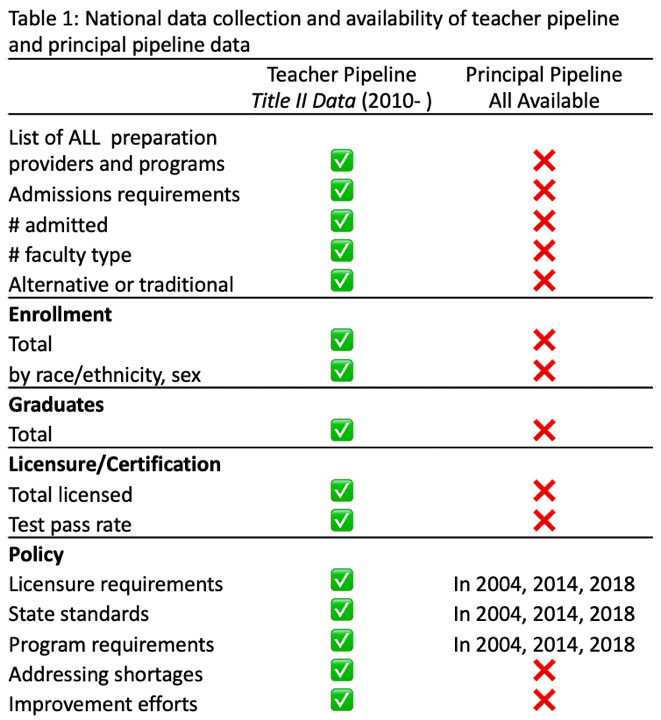
Data for a Quality and Diverse Principal Pipeline
Summary
Just as with teachers, the pipeline of prospective school principals is thin and lacking diversity. But unlike with teachers, data on the principal pipeline is sparse, preventing better understandings of the challenges and potential for recruiting and preparing a quality and diverse principal corps. This brief offers suggestions to easily address the paucity of data on prospective principals.
The school principal is vital for PK-12 outcomes. In the wake of COVID and with a persistently and predominantly White educator workforce, increased concerns about a shortage of quality principals and principals of color mirror those for the teaching field. However, most policymakers, state/district stakeholders, and researchers cannot answer critical principal staffing and pipeline questions under current data systems reporting and availability. For instance:
- How many principals and assistant principals are qualified and available to fill current and future openings?
- Are principal candidates of color proportionately represented in our principal pipeline?
- From where can we recruit qualified principal candidates?
- Where are principal candidates being prepared and what is the quality of their preparation?
- How do our state policies influence principal preparation and certification?
Except in a handful of states, these types of questions can be answered using data on the teacher pipeline but not the principal pipeline. Teacher data collection and availability are (a) mandated at the federal level, (b) sometimes at the state level, and (c) often prioritized at state and district levels. The contrast between teacher pipeline data availability versus principal pipeline data is stark (see Table 1 for comparison at national level).
Research using the few rich state datasets available illustrates, however, the insights that a rich data collection and availability system can provide. For instance, several studies using such data strongly suggest forms of racial discrimination are evident across the principal pipeline. For instance, research using state data we know:

- Missouri and Tennessee licensure test cutoff scores are unpredictive of performance but have screened out substantial numbers of quality candidates of color.
- Black educators with principal licensure in Texas take longer or are less likely to reach the principalship than their White peers (see Perrone (2022) for more examples).
Unfortunately, such valuable insights are sparse due to inadequate data collection and availability at both national and state levels.
Pathways Forward
The need for better principal pipeline data collection and availability can be addressed in straightforward and affordable ways. Doing so better ensures that issues of principal supply/demand, equity and representation by race/ethnicity/ sex, principal quality, and preparation quality are assessed.
Expanding National Data Collection
Since 2010, Title II: Teacher Quality Enhancement of the Higher Education Act (HEA) has required each state to collect and report an array of teacher pipeline data, but not principal pipeline data. This has informed policy on teacher preparation, certification, and licensure, and enabled assessment of state-level teacher supply and recruitment issues. All of these data are publicly available (https://title2.ed.gov).
Reauthorization of the HEA should include a mandate to capture the same principal preparation and licensure information. This expansion would come at a marginal cost because most principal preparation programs are in schools that already report Title II teacher pipeline data.
Expanding State Data Collection
Only a few states have collected and made available data integral to answering key questions about the principal pipeline. State collection and restricted release of key data, such as licensure test scores, preparation program graduates, and principal licensure-holders by race and sex over time, would complement national Title IItype data and enable informed research and decision-making to promote a higher-quality, more diverse principal workforce.
However, scarcity of state-level data availability is not always necessarily due to low capacity or resources. Many states already have the infrastructure to collect these principal pipeline data, but simply do not use this infrastructure. Other states do collect such principal pipeline data but do not make them available, while some states have yet to build sufficient data infrastructures.
We first advise that state education agencies (SEAs) tackle improvements with marginal costs. Most glaringly, all states with infrastructure in place should naturally expand their data collection and restricted data access to include principal pipeline data. Second, states that collect but do not make such principal data available should consider sharing restricted-level data with researchers to foster understandings of the principal pipeline.
We acknowledge that while SEAs should further prioritize principal data efforts, some SEAs may then struggle to reallocate financial resources. Thus, we also urge the U.S. Department of Education to support SEAs by extending its Statewide Longitudinal Data System grant competition to further target data collection, reporting, and availability of pertinent principal pipeline data to parallel those in place for teacher pipeline data.
This brief is based on a manuscript published as: Perrone, F., Young, M. D., & Fuller, E. J. (2022). A call for data on the principal pipeline. Educational Researcher, 51(6), 423-430. https://doi.org/10.3102/0013189X22107 5767
Authors
Frank Perrone is an assistant professor of educational leadership at Indiana University.
Michelle D. Young is a professor of education leadership and policy and dean of the School of Education at Loyola Marymount University and UCEA executive director emeritus.
Edited by: Christopher Lubienski, PhD, Center for Evaluation and Education Policy

